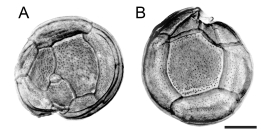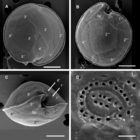
| Home | | Literature | | Log in |
| Diatoms | | Haptophytes | | Dinoflagellates | | Raphidophyceans | | Dictyochophyceans | | Pelagophyceans | | Cyanobacteria | | Greylist | | Harmful non-toxic |
HABs taxon detailsGambierdiscus silvae S.Fraga & F.Rodríguez, 2014
833053 (urn:lsid:marinespecies.org:taxname:833053)
accepted
Species
marine
Fraga, S.; Rodríguez, F. (2014). Genus Gambierdiscus in the Canary Islands (NE Atlantic Ocean) with Description of Gambierdiscus silvae sp. nov., a New Potentially Toxic Epiphytic Benthic Dinoflagellate. <em>Protist.</em> 165(6): 839-853., available online at https://doi.org/10.1016/j.protis.2014.09.003 [details]
Harmful effect Production of 44-methylgambierone and gambierone has been shown (Mudge et al. 2022). Strains test positive to NCBA (Pisapia...
Harmful effect Production of 44-methylgambierone and gambierone has been shown (Mudge et al. 2022). Strains test positive to NCBA (Pisapia et al. 2017). Mudge et al. (2023) identified a novel C-CTX analogue, C-CTX5, from Gambierdiscus silvae strains from the Caribbean. Metabolism in vitro by fish liver microsomes converted algal C-CTX5 into C-CTX1/2, the dominant CTX in ciguatoxic fish from the Caribbean. Furthermore, C-CTX5 from G. silvae was confirmed to have voltage-gated sodium-channel-specific activity. [details] Identification Gambierdiscus silvae has a hatchet-shaped Plate 2' , an asymmetrical 3'' and a broad 2'''', as G. polynesiensis and G....
Identification Gambierdiscus silvae has a hatchet-shaped Plate 2' , an asymmetrical 3'' and a broad 2'''', as G. polynesiensis and G. carolinianus. It is very similar to G. polynesiensis in general shape and tabulation but it differs from it in the lack of the distinct fold formed by 4', 1' and 1'' in G. polynesiensis (named as 1' , 1'' and 2'' in Litaker et al. 2009). The shape of Po, which is oval in G. silvae and triangular in G. polynesiensis, while in ventral view G. silvae is almost symmetrical compared to G. polynesiensis and has also different plate textures. G. silvae differs from G. carolinianus in the shape of 1' which in G. carolinianus is shorter than in G. silvae. G.carolinianus is also wider than deep while G. silvae is deeper than wide. Gambierdiscus sp. type 4 as described by Xu et al. (2014) looks like G. silvae in their figures 5A and C by the shape of 2' and the difference in texture between apical and precingular plates, but the hypotheca looks different as Plate 2'''' (their 1p) looks not as wide as in G. silvae. [details]
Guiry, M.D. & Guiry, G.M. (2024). AlgaeBase. World-wide electronic publication, National University of Ireland, Galway (taxonomic information republished from AlgaeBase with permission of M.D. Guiry). Gambierdiscus silvae S.Fraga & F.Rodríguez, 2014. Accessed through: Lundholm, N.; Churro, C.; Escalera, L.; Fraga, S.; Hoppenrath, M.; Iwataki, M.; Larsen, J.; Mertens, K.; Moestrup, Ø.; Murray, S.; Tillmann, U.; Zingone, A. (Eds) (2009 onwards) IOC-UNESCO Taxonomic Reference List of Harmful Micro Algae at: https://www.marinespecies.org/hab/aphia.php?p=taxdetails&id=833053 on 2024-04-24
Lundholm, N.; Churro, C.; Escalera, L.; Fraga, S.; Hoppenrath, M.; Iwataki, M.; Larsen, J.; Mertens, K.; Moestrup, Ø.; Murray, S.; Tillmann, U.; Zingone, A. (Eds) (2009 onwards). IOC-UNESCO Taxonomic Reference List of Harmful Micro Algae. Gambierdiscus silvae S.Fraga & F.Rodríguez, 2014. Accessed at: https://www.marinespecies.org/hab/aphia.php?p=taxdetails&id=833053 on 2024-04-24
Date action by
original description
Fraga, S.; Rodríguez, F. (2014). Genus Gambierdiscus in the Canary Islands (NE Atlantic Ocean) with Description of Gambierdiscus silvae sp. nov., a New Potentially Toxic Epiphytic Benthic Dinoflagellate. <em>Protist.</em> 165(6): 839-853., available online at https://doi.org/10.1016/j.protis.2014.09.003 [details]
basis of record Guiry, M.D. & Guiry, G.M. (2023). AlgaeBase. <em>World-wide electronic publication, National University of Ireland, Galway.</em> searched on YYYY-MM-DD., available online at http://www.algaebase.org [details] additional source Litaker, R.W., Vandersea, M.W., Faust, M.A., Kibler, S.R., Nau, A.W., Holland, W.C., Chinain, M., Holmes, M.J., Tester, P.A. (2010). Global distribution of ciguatera causing dinoflagellates in the Genus Gambierdiscus. <em>Toxicon.</em> 56, 711-730., available online at https://doi.org/10.1016/j.toxicon.2010.05.017 [details]  Present Present  Inaccurate Inaccurate  Introduced: alien Introduced: alien  Containing type locality Containing type locality
From regional or thematic species database
Description Cells anterioposteriorly compressed,lenticular in shape with an epitheca slightly higher than hypotheca with averaged length 46 ± 5 μm,depth 69 ± 8 μm, and width 64 ± 9 μm. It is round in apical view and has a thick smooth theca in apical and antapical plates, and slightly ornamented in pre- and postcingular plates, with many scattered pores. Plate formula is Po, 4', 0a, 6'', 6c, 6s?,5''', 0p, 2''''. Apical pore complex, Po is oval, has a fishhook-shaped slit, is centred in the epitheca andonly slightly ventrally displaced. Plate 2’ is hatchet-shaped and is the biggest of the apical plates. Plate 2'''' is the biggest of hypotheca and is very wide in relation to the length. The nucleus is U shaped and is located in the dorsal part of the cell withpoints towards the ventral side of the cell. Cells are photosynthetic having numerous small and round chloroplasts. [details]Harmful effect Production of 44-methylgambierone and gambierone has been shown (Mudge et al. 2022). Strains test positive to NCBA (Pisapia et al. 2017). Mudge et al. (2023) identified a novel C-CTX analogue, C-CTX5, from Gambierdiscus silvae strains from the Caribbean. Metabolism in vitro by fish liver microsomes converted algal C-CTX5 into C-CTX1/2, the dominant CTX in ciguatoxic fish from the Caribbean. Furthermore, C-CTX5 from G. silvae was confirmed to have voltage-gated sodium-channel-specific activity. [details] Identification Gambierdiscus silvae has a hatchet-shaped Plate 2' , an asymmetrical 3'' and a broad 2'''', as G. polynesiensis and G. carolinianus. It is very similar to G. polynesiensis in general shape and tabulation but it differs from it in the lack of the distinct fold formed by 4', 1' and 1'' in G. polynesiensis (named as 1' , 1'' and 2'' in Litaker et al. 2009). The shape of Po, which is oval in G. silvae and triangular in G. polynesiensis, while in ventral view G. silvae is almost symmetrical compared to G. polynesiensis and has also different plate textures. G. silvae differs from G. carolinianus in the shape of 1' which in G. carolinianus is shorter than in G. silvae. G.carolinianus is also wider than deep while G. silvae is deeper than wide. Gambierdiscus sp. type 4 as described by Xu et al. (2014) looks like G. silvae in their figures 5A and C by the shape of 2' and the difference in texture between apical and precingular plates, but the hypotheca looks different as Plate 2'''' (their 1p) looks not as wide as in G. silvae. [details] |


